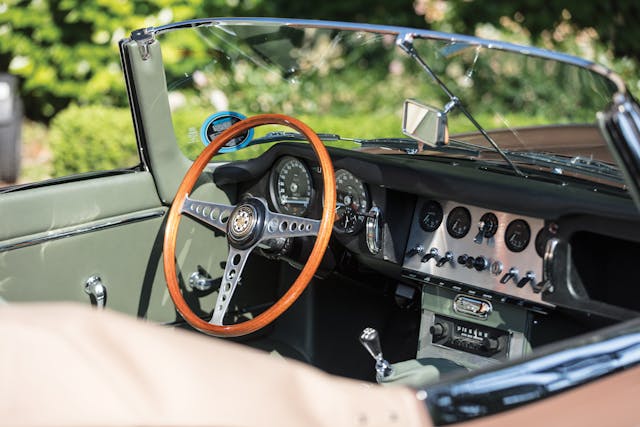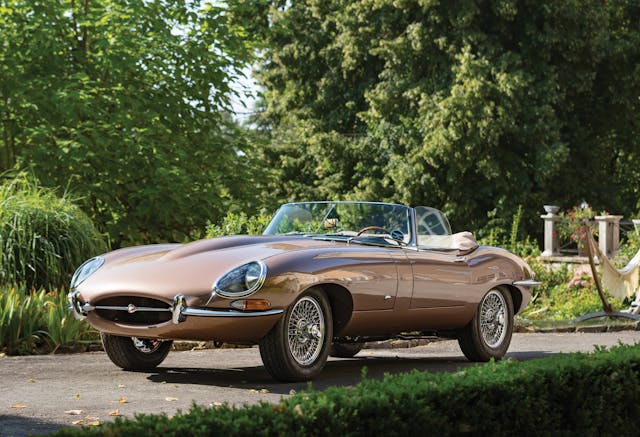Media | Articles
Wayne Carini: “I’ve evolved right along with the E-Type”
In 1961, I was a 10-year-old kid doing routine chores at my father’s Connecticut body and restoration shop when William Diefenderfer walked in. He was a senior engineering executive at the nearby Hamilton Standard aerospace conglomerate, and he was driving the most beautiful car I’d ever seen. The sleek lines of that bronze Jaguar E-Type are burned in my memory.
The E-Type grew out of Jaguar’s racing program of the 1950s and its Le Mans-winning C- and D-Types. With independent rear suspension and inboard rear brakes, E-Types were ahead of just about anything of the day.
Diefenderfer bought an early coupe directly from the factory and had it air-freighted across the Atlantic. During transit, his E-Type sustained damage behind the right rear wheel and to the rear bumper. With almost no parts in the United States, however, Diefenderfer flew to England, picked up a new bumper, and returned home two days later. My father repaired the Jag, and I was all over that amazing car while he had it.

Almost no one had ever seen one, so I told all my friends about the E-Type. Soon there were all these kids riding their bikes to the shop to see it. I thought it was fantastic to tilt that long nose up and see the gold head, the polished cam covers, and those triple SU carburetors. The side-opening rear hatch and broad sills were just amazing. Even better, Dad drove me home in it a few times. The sounds it made!
When the car was finished, Diefenderfer took me up and down the street in it. He drove it a lot harder than my dad, who treated it like it was irreplaceable—which, at the time, it was.
Marketplace
Buy and sell classics with confidence
After my first taste of the E-Type, whenever my father made a trip to Corona’s junkyard in Hartford, I’d pester him to swing by the local Jaguar dealer, Pallotti & Poole, where I’d drool over the new models.
By the time I was about 20, I’d driven Ferraris, Maseratis, and Iso Grifos, and with their V-8 and V-12 engines, I guess I never expected much from the six-cylinder Jaguar. When I finally drove an E-Type, however, I found similar performance but a smoother experience and lighter feel, especially compared with something like the Ferrari Daytona.

Sometime later, I was able to buy a silver E-Type 3.8 with door and quarter-panel damage for very little, thinking I’d fix it and flip it. I repaired the door and quarter and spot-painted them both. While I was gone one day, my dad sold it to a guy who had stopped by the shop. I wasn’t quite ready to part with it, but I made about $800 in the process.
About 10 years ago, I decided to buy an E-Type for myself. Simultaneously, a client asked me to find him an early coupe to match one he’d seen in a photo. I tracked down the owner of the car pictured. He was moving and sold me the low-mileage Jaguar. When I took it to the client, I hoped he’d balk at the price and I’d be able to keep it. No such luck—he bought it. Several years later, however, I was able to buy the coupe back from him. I drove and enjoyed it for a while, until another client saw it in the shop and really wanted it. The car wasn’t for sale, so I priced it at the high end of the market, figuring he’d flinch. He didn’t.

Early E-Types will always be my favorites. The shape and the details of those Series I cars are timeless. Series II cars, by contrast, had the uncovered headlights and bigger parking and taillights, which I never liked very much. These days, I’ve overcome that and appreciate the Series II and III E-Types. Currently, I’ve got a ’73 roadster with a four-speed. The Series IIIs are longer and heavier than their predecessors, and it took me some time to come to terms with the appearance, but the V-12 is super-smooth, and I love the driving experience.
I suppose that’s proof that I’ve evolved right along with the E-Type. Since I first saw Diefenderfer’s car back in 1961, there hasn’t been much that could match it. I don’t imagine I’ll change my mind anytime soon.






